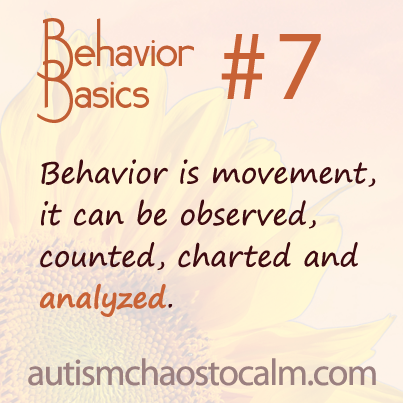 7. Behavior is movement.
7. Behavior is movement.
It can be observed, counted, charted and analyzed.
After you have observed, counted and charted a learner’s behavior (physical movements), you can analyze the data. This analysis is called a Functional Behavior Assessment (FBA). The purpose of the FBA is to determine what function the behavior serves for the learner: i.e., the learner is doing this behavior for a reason, so what is the student gaining from this behavior? Studying the consequences that follow the behavior will shed light on this question. Some common reasons for learners to engage in behaviors are to gain attention, seek relief (escape), or divert attention. There are many other potential reasons.
8. Behavior is movement.
It can be observed, counted, charted, analyzed and changed.
After the behavior has been analyzed, the next step is to set up a plan so that the learner can achieve his/her needs (as determined by the FBA) in more acceptable ways. Often, a decision is made to provide positive reinforcement for an alternative, acceptable behavior to replace the less desirable behavior. We know from behavioral science that a behavior that is reinforced is a behavior that will occur more often. With consistent delivery of positive reinforcement, along with monitoring the behavior plan and making adjustments as indicated by data, it is possible to make good progress in achieving helpful behavior change in a sensitive, humane manner.
REMINDER: This concludes the wrap-up of Behavior Basics for the week. Please remember the schedule: On the release date of each module, the Behavior Basics for that module will be compiled into a PDF ebook available from our blog and Facebook page. Click on this link to download the entire series of 42 Behavior Basics for free: http://statictab.com/m7bizwt.
